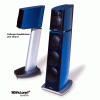- Thread Starter
- #21
From the Grimm site,
The LS1s-dmf subwoofer was developed in cooperation with Rob Munnig Schmidt, who worked at Philips and ASML and was professor at the Technical University Delft. Rob explains his design motives:
"Being lifelong fascinated by precision control of motion systems and sound reproduction I never was happy with the unbalance in audio design between electronics and mechanics. On one side designers do everything to reduce distortion in electronics by means of feedback to almost unmeasurably low levels, while on the other side the real music is reproduced by electromechanical structures, called loudspeakers, without any control of their behaviour. Although many people agree that the loudspeaker is one of the most determining factors for the quality in an audio chain, strangely enough people accept that all loudspeakers have a well distinguishable character due to resonances, non-linearity, diffraction etc.
For this reason I immediately said yes when Grimm Audio asked me to design a motional feedback version of their LS1s subwoofer with a digital DSP controller, based on my experience with this principle. It covers the frequency range where control is most needed, the low frequencies around the fundamental resonance. By applying a sensitive acceleration sensor with low distortion on a rugged and powerful driver the real sound output is controlled such that the resonance disappears and distortion is significantly reduced. The effect is readily audible by its clean and dry bass where a base drum with damping blanket really gives short well controlled bumps, while organ tones to even below 20 Hz are reproduced faithfully such that you feel it rather than hear it. It is so rewarding to see people who hear the new DMF sub show real surprise when realising how much better bass reproduction can be."
Rob Munnig Schmidt
The LS1s-dmf subwoofer was developed in cooperation with Rob Munnig Schmidt, who worked at Philips and ASML and was professor at the Technical University Delft. Rob explains his design motives:
"Being lifelong fascinated by precision control of motion systems and sound reproduction I never was happy with the unbalance in audio design between electronics and mechanics. On one side designers do everything to reduce distortion in electronics by means of feedback to almost unmeasurably low levels, while on the other side the real music is reproduced by electromechanical structures, called loudspeakers, without any control of their behaviour. Although many people agree that the loudspeaker is one of the most determining factors for the quality in an audio chain, strangely enough people accept that all loudspeakers have a well distinguishable character due to resonances, non-linearity, diffraction etc.
For this reason I immediately said yes when Grimm Audio asked me to design a motional feedback version of their LS1s subwoofer with a digital DSP controller, based on my experience with this principle. It covers the frequency range where control is most needed, the low frequencies around the fundamental resonance. By applying a sensitive acceleration sensor with low distortion on a rugged and powerful driver the real sound output is controlled such that the resonance disappears and distortion is significantly reduced. The effect is readily audible by its clean and dry bass where a base drum with damping blanket really gives short well controlled bumps, while organ tones to even below 20 Hz are reproduced faithfully such that you feel it rather than hear it. It is so rewarding to see people who hear the new DMF sub show real surprise when realising how much better bass reproduction can be."
Rob Munnig Schmidt

